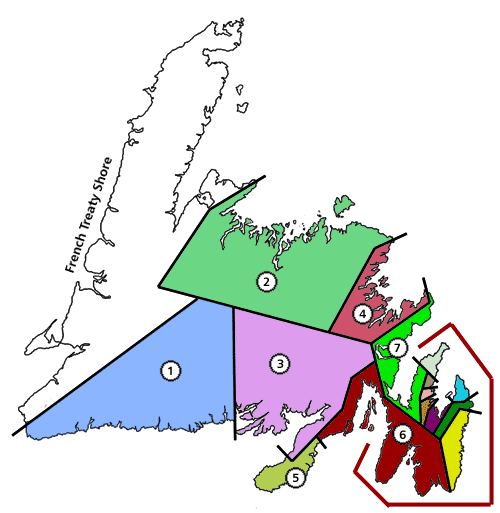The Confederation Election of 1869
Campaigning for Confederation
Premier Frederic Carter called a general election for 13 November 1869, in which the central issue was whether or not Newfoundland should join the Dominion of Canada. In the other colonies which had joined, the decision had been taken by the legislature without direct consultation with the electorate. In Newfoundland it had been agreed as early as 1865 that an election would be needed to settle the matter.
Both the Conservative and Liberal parties were divided on the issue of confederation, with the result that specifically confederate and anti-confederate groupings emerged for the election. The Confederates, led by Carter, were supported by a section of the Conservatives, and had since 1865 included a few leading Liberals, including Ambrose Shea. Most Liberals (representing predominantly Roman Catholic districts) were Anti-Confederates, however, and they were joined by a significant number of Conservatives, most of them merchants. Their leader was Charles Fox Bennett, a prominent St. John's merchant and mine owner, who had opposed confederation from the beginning.
The campaign was bitter and hard-fought. Though 76 years of age, Bennett actively canvassed outport districts in a 140-ton steamer. Newspapers on both sides published large amounts of propaganda.
Anti-Confederate Propaganda
A major issue was the probable level of taxation after confederation. The Antis succeeded in convincing many voters that the Canadians would tax everything and anything, and that everyone would pay far more than at present. Another Anti-Confederate scare was that young men would be conscripted into the Canadian armed forces and forced, as Bennett put it, "to shed their blood and leave their bones to bleach in a foreign land, in defence of the Canadian line of boundary." Above all, they held that confederation was a Canadian scheme which could only damage, rather than help Newfoundland.
The confederates tried to counter this propaganda, but found it difficult to do so. A major part of the counter-attack was a personal attack on Bennett who, it was said, was in the fight only to protect his business, his investments, and above all to his possession of mining rights over a million acres in Bay d'Espoir, Fortune Bay and the Burin Peninsula.
The Vote
In the end, the anti-confederates won the election by 21 seats to nine. They won all the districts with Roman Catholic majorities, Notre Dame and Bonavista bays, and three seats elsewhere. In predominantly Protestant districts, the influence of the local merchants was important in deciding the results - remember, there was no secret ballot in the 1860s.

The voting figures are known for only a few districts. In Twillingate-Fogo and Bonavista Bay, each of the five confederate candidates averaged 376 votes, while the Anti-Confederates averaged 818 votes each, a huge majority. In Brigus-Port de Grave, the Anti-Confederate majority was a healthy 634 votes - 75 percent of the vote. The Confederate candidate in St. John's East only managed to get 412 votes, while his opponents got over 1,000 each. In Placentia-St. Mary's the three Confederates (one of them Ambrose Shea) received a mere 293 votes - the anti-confederates 2,614.
Opposing Confederation
The election showed clearly that most Newfoundlanders were strongly opposed to confederation. If it was a vote of no-confidence in Canada, it was also a vote of confidence in Newfoundland, an assertion of confidence that the colony had the resources to survive and prosper on its own. It was obvious that for the foreseeable future, confederation was not an acceptable option, and that the colony would go it alone.
Cheer up, my gallant countrymen,
The fight is fought and won.
Confederates are routed,
And beaten two to one.
The people have declared their will,
The people's voice has spoke,
They ne'er will bend to alien laws
Or to a foreign yoke.
So now Confederation
A shameful death has died.
'Tis buried up at Riverhead
Beneath the flowing tide.
And may it never rise again
To bother us, I pray!
Hurrah, my boys, for Liberty,
The Antis gained the day.
Results of the 1869 General Election
| District | Turnout | Confederates | Anti-Confederates |
|---|---|---|---|
| Twillingate-Fogo | 70.3 % | Whiteway, Dr E. Knight |
Duder, McKay |
| Bonavista Bay | 77.1 % | Warren, Burton, Carroll |
Noonan, Barnes, Winton |
| Trinity Bay | 87.8 % | Rendell, Ridley, Watson |
Alsop, March |
| Bay de Verde | 70.9 % | Bemister | Reader |
| Carbonear | 80.2 % | Rorke | Taylor |
| Harbour Grace | 82.5 % | Munn, Green |
Prendergast, Dawe |
| Brigus-Port de Grave | 87.8 % | Pinsent | Wood |
| St. John's East | 65.9 % | Parsons, W. | Walsh, Jordan, Parsons, R. |
| St. John's West | No contest | - |
Brennan, Talbot, Renouf |
| Harbour Main | No contest | - |
Little, Kennedy |
| Ferryland | No contest | - |
Glen, Badcock |
| Placentia-St. Mary's | 71.1 % | Shea, Barron, O'Reilly |
Bennett, C., Parsons R.J., Renouf |
| Burin | 85.4 % | Carter, Evans |
LeMessurier, Woods |
| Fortune Bay | No contest | - |
Bennett, T. |
| Burgeo-La Poile | No contest | Emerson | - |
| 77.9 % avg. | 9 elected | 21 elected |




